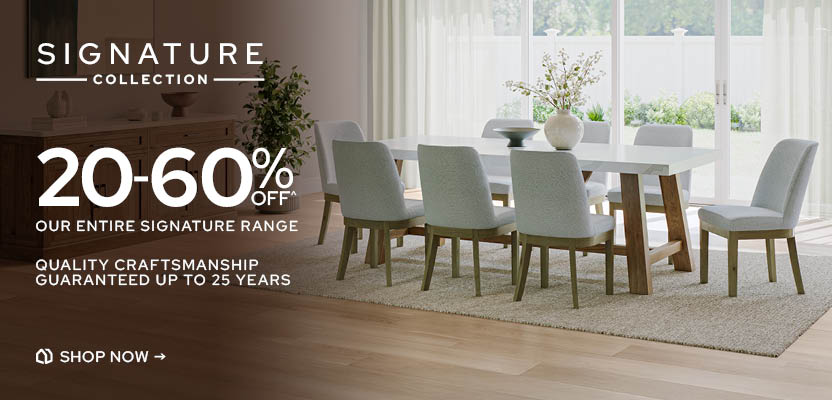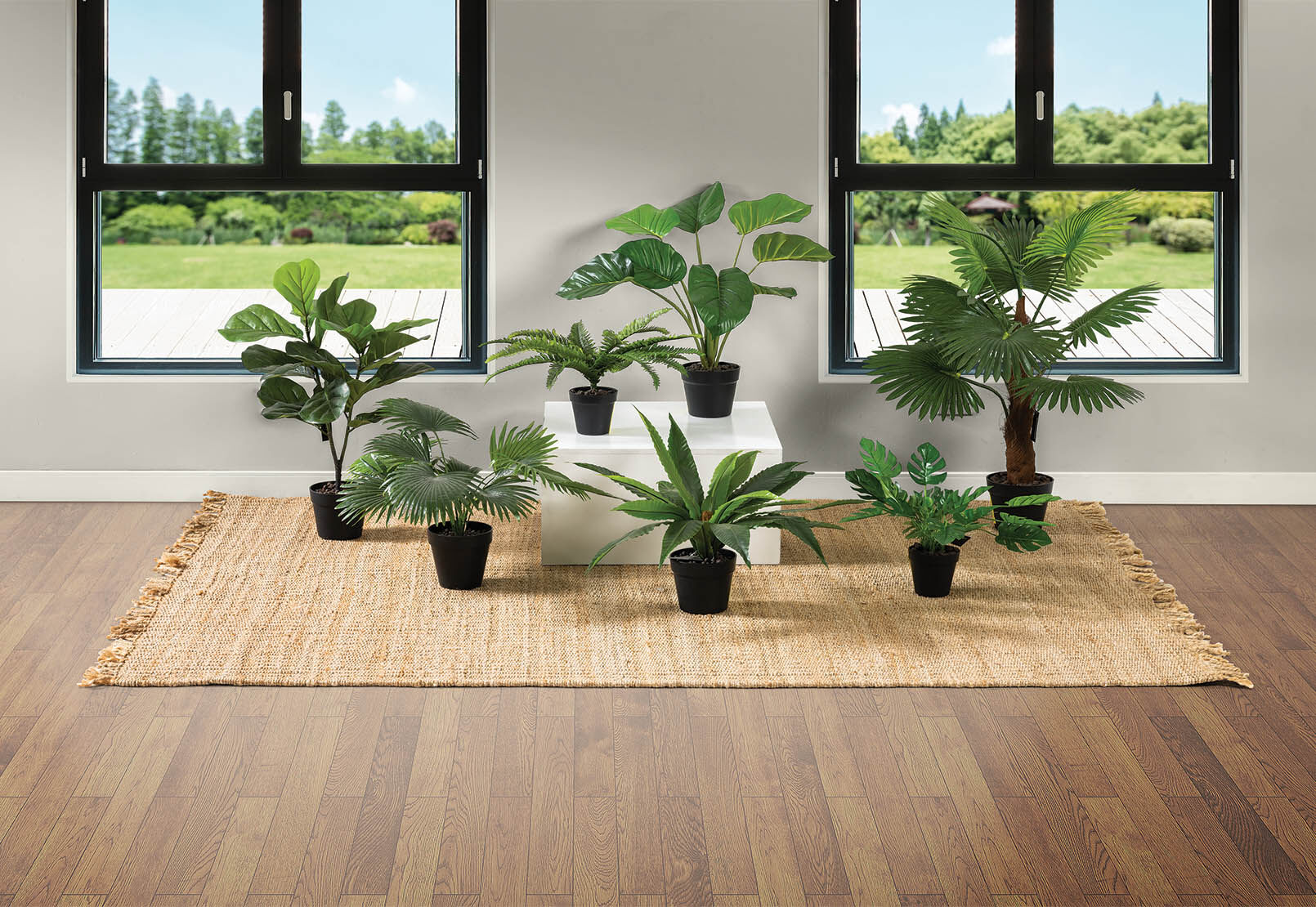Your in-depth plants and pots buyer’s guide
Plants and pots bring the outside in and fill your spaces with splashes of vibrant green and natural beauty. At Amart, you can decorate your indoor and outdoor areas with our range of planters, pots and artificial plants in every size, style and type. There’s a lot to consider before making a purchase - do you plan on watering a real plant in a stunning ceramic planter or do you like the no-fuss, no-mess option of owning an artificial plant in a plastic plant stand?
We’ve put together a handy plants and pots buying guide to help you make the right decisions and invite a little bit of green into your home.
Things to consider
Before you rush off to buy your plants and pots, spend some time thinking through these factors so you will have a clearer idea of what will and won’t work for you and your lifestyle:
- The place - The first thing you need to decide is whether you want to place your plant indoors or outdoors. Indoor plants bring the outdoors into your home to freshen up your interiors. Artificial plants can be placed anywhere, as a feature piece or scattered around the rooms. If you plan on using real plants, you’ll need to choose the right species that can thrive indoors and position them appropriately. Outdoor plants liven up your alfresco dining areas. Real or artificial, potted plants look beautiful on the patio and can be used to create a secluded, leafy corner in the garden for entertaining.
- The function - While artificial plants can just sit pretty with little care and maintenance aside from the occasional dusting, real plants need more TLC. Potted plants require drainage holes to remove excess water and prevent root rot. Good drainage will keep your real plants lush and healthy inside or outside the home. If the pot that your plant is growing in becomes too small, you will also need to move it into a larger pot so that the plant roots have room to expand. Self-watering pots are a great idea for beginner plant enthusiasts as they let plants drink at their own pace and let you know when you need to refill the reservoir.
- The size - Do you want a large or small plant and pot? Large plants stand out and make stunning feature pieces while small plants are great for small homes and add a little pop of green here and there. If you have the space, consider buying a cluster of large and small plants of varying species to decorate an area, such as a group of succulents and cacti placed on a windowsill or table.
- The style - Flower pots, plant containers, plant stands and vases come in a dazzling array of colours, designs and materials to match your home decor. A fibreglass cylinder is sleek and modern, filled with flowers while a large terracotta planter will look rustic sitting in the garden. There are elegant vases and retro vases, as well as planters in bright colours and materials that range from ceramic to rope. Consider whether you want your pot to be the star attraction or the plant. Choose neutral tones with plain designs if you want your plant to be the hero and vibrant pots and planters with fun patterns and unique designs if not.
- The type - There are many types of plants, from flowering plants to leafy greens and easy-to-care for succulents. The best plants for indoors include Peace Lily, Monstera, Moth Orchids and Maidenhair Fern. Succulents are ideal for busy households as they don’t require much watering and are low maintenance. If you don’t have a green thumb at all, consider adding an artificial plant to your home instead!
Real vs. artificial plants
The big question - do you choose real or artificial plants? There’s no doubt that real plants are a joy in the home. A flowering plant will brighten up your room and fill it with colour each time it blooms. If you’re into landscape design, DIY gardening and getting your hands dirty, real plants are most likely for you. While aesthetically beautiful, real plants do require a lot of attention and you’ll need to be prepared to care for them to keep them healthy.
On the other hand, if you love the green that a plant brings but don’t want to or have the time or means to care for it, choose a high-quality, long-lasting artificial plant for all of the joy without the extra fuss. Artificial plants have come a long way and can now look exactly like the real thing. The best part about them is that they require no maintenance besides the occasional wipe-down and are guaranteed to survive and look good no matter what happens!
Another fabulous idea is to skip the plant altogether and decorate your home with empty pots, vases and planters. These vessels can look like works of art in a room and you can vary the size and shape of them to add visual interest.
Indoor planters vs. vases
Confused about the difference between an indoor planter and a vase? Read on:
- Indoor planter - Indoor planters are generally larger than vases and are designed with functionality in mind. In other words, you can use planters to grow plants as they are made with the right materials to accommodate soil and water with drainage holes in the base to ensure your plants stay healthy. You can find indoor planters as well as outdoor planters for outdoor use that brighten up balconies and patios.
- Vase - A vase is typically a decorative item used to display flowers or plants that have been cut. They’re usually smaller and more cylindrical in shape as they don’t need to accommodate any soil and don’t have holes in the base for a plant to grow. Fill vases with beautiful fresh flower bouquets or get creative with branches and dried flowers.
Costs
Think about your budget when it comes to buying plants and pots. Real plants are a long-term investment; you’ll need to buy the plant and the pot first, then potentially other items such as potting mix, fertilisers, insecticides and larger pots down the line to keep them healthy. You’ll also need to water them regularly.
An artificial plant is one outright payment and you’re set. This is a much cheaper option due to the low maintenance of artificial plants. You also won’t need to replace them if you forget to water them!
The material of your plant or flower pot
There are many types of pots to choose from. The material of your pot determines the texture and look of the pot. It’s a good idea to choose one that fits into your existing style and colour palette. You can find pots made from:
- Clay & terracotta - These are some of the best planters for outdoor use. Clay and terracotta pots are classic, rustic and add warmth to a space that contrasts with the green of a plant.
- Glazed vs unglazed - Unglazed pots retain their porous properties so they allow great air circulation and moisture evaporation while glazed pots keep moisture in and prevent the soil from drying out. This is helpful with plants that thrive in moist environments.
- Concrete - A concrete planter is durable, beautiful and affordable. Their only downside is that they can be very heavy depending on the size.
- Terrazzo - A terrazzo planter is visually attractive and can look like a piece of art in itself with little chips of stones and glass scattered through the mixture. They are typically lightweight and durable.
- Fibreglass - Fibreglass is durable and high-quality with excellent plant-protection properties. They’re lightweight and durable but can accurately mimic terracotta, concrete, wood and more.
- Plastic - Super affordable, plastic planters are also lightweight and durable. A plastic pot can be plain and simple or colourful with attractive finishes that mimic stone and other materials.
- Ceramic - Ceramic pots are glazed and come in a range of colours that contrast well with plants. Go bright and bold or choose earthy tones for adding a warm touch to spaces.
- Metal - Metal planters look modern and sleek and can be made from steel, aluminium, zinc, copper and other types of metals. They need to have drainage holes in them as the material is not porous. A metal pot is also not suitable for outdoor use as it will rust when exposed to the elements.
- Wood - Wooden planters have a rustic charm that looks wonderful in coastal, Scandinavian and country-style homes. Wood planters can be used indoors or outdoors and can be made from many different types of wood with different colours and grain patterns. They’re 100% natural and should be sealed to prevent the wood from rotting when exposed to water.














